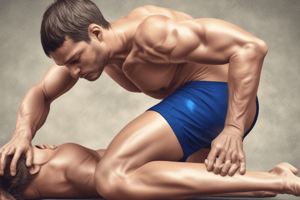Podcast
Questions and Answers
Which of the following is NOT a mechanical factor contributing to low back pain?
Which of the following is NOT a mechanical factor contributing to low back pain?
- Arthritis (correct)
- Poor posture
- Herniated discs
- Muscle strains
What is a crucial step in managing low back pain caused by infections?
What is a crucial step in managing low back pain caused by infections?
- Surgery
- Chiropractic adjustments
- Physical therapy
- Antibiotic treatment (correct)
How can arthritis contribute to low back pain?
How can arthritis contribute to low back pain?
- By strengthening the spine muscles
- By causing joint inflammation and damage (correct)
- By reducing inflammation
- By improving joint flexibility
What can help prevent mechanical issues leading to low back pain?
What can help prevent mechanical issues leading to low back pain?
Which symptom is NOT commonly associated with low back pain?
Which symptom is NOT commonly associated with low back pain?
How can cancer exacerbate low back pain?
How can cancer exacerbate low back pain?
What is the first line of treatment for mechanical low back pain?
What is the first line of treatment for mechanical low back pain?
Which structures are involved in low back pain, acting as shock absorbers between vertebrae?
Which structures are involved in low back pain, acting as shock absorbers between vertebrae?
When are surgery options typically considered for low back pain?
When are surgery options typically considered for low back pain?
What do neurological deficits like numbness and weakness suggest in cases of low back pain?
What do neurological deficits like numbness and weakness suggest in cases of low back pain?
Which condition directly involves the bony lumbar vertebrae in low back pain?
Which condition directly involves the bony lumbar vertebrae in low back pain?
What is the role of facet joints in the lumbar spine?
What is the role of facet joints in the lumbar spine?
Flashcards are hidden until you start studying
Study Notes
Low Back Pain
Low back pain is a common condition affecting people of all ages. It can range from mild discomfort to severe chronic pain. This article aims to explore the various aspects of low back pain, including its causes, symptoms, treatments, and the associated anatomy.
Causes
Mechanical Factors
Mechanical factors such as poor posture, muscle strains, herniated discs, spinal stenosis, and degenerative disc disease contribute significantly to low back pain. Maintaining good posture and exercising regularly can help prevent mechanical issues.
Arthritis
Arthritis, particularly osteoarthritis and rheumatoid arthritis, can lead to low back pain due to inflammation and joint damage. Managing arthritis through medication, physical therapy, and lifestyle changes can alleviate these pains.
Infection
Infections within the spine and surrounding tissues can cause severe low back pain. Early detection and antibiotic treatment are crucial in managing this type of pain.
Cancer
Cancerous growths, most commonly due to metastasis, may also exacerbate low back pain. Regular screenings and appropriate cancer management strategies, like chemotherapy and radiation therapy, can help mitigate the pain.
Symptoms
Symptoms vary widely depending on the underlying cause of the low back pain. They can include localized tenderness, pain upon movement, stiffness, and sometimes referred pain down the legs. Neurological deficits like numbness, tingling, and weakness suggest nerve involvement requiring immediate medical attention.
Treatments
Treatment options depend on the cause of the low back pain. For mechanical pains, rest, exercise, and over-the-counter medications can suffice. Acute episodes may require prescription painkillers or anti-inflammatory agents. Physical therapy, massage, and chiropractic care have shown promise in certain situations. Surgery is rarely indicated unless the pain persists despite conservative measures and there's evidence of serious underlying pathology.
Anatomy
Key structures involved in low back pain include the bony lumbar vertebrae, intervertebral discs, facet joints, spinal nerves, and muscles. Understanding their roles can aid in understanding how injuries and conditions affect the region.
The bones - vertebrae - form the central pillar of the spine. Between each are cartilaginous pads called intervertebral discs, which act as shock absorbers and allow some degree of movement between the vertebrae. Facet joints, located at the back of the vertebrae, enable smooth movement and stability. Nerves branch off from the spinal cord, transmitting sensations to different parts of the body.
Understanding the structure of the lumbar spine helps in comprehending potential sources of pain. Conditions like degenerative disc disease, spinal stenosis, and herniated discs involve these structures directly. Knowledge of these anatomical relationships facilitates better communication with healthcare providers and ultimately contributes to effective management of low back pain.
Studying That Suits You
Use AI to generate personalized quizzes and flashcards to suit your learning preferences.




